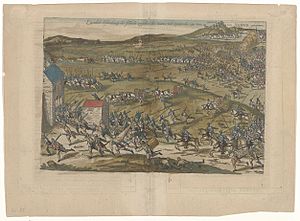| Battle of Gembloux | |||||||
|---|---|---|---|---|---|---|---|
| Part of the Eighty Years' War | |||||||
 Engraving of the Battle of Gembloux by Georg Braun | |||||||
| |||||||
| Belligerents | |||||||
|
|
| ||||||
| Commanders and leaders | |||||||
|
|
| ||||||
| Strength | |||||||
| 25,000 men |
17,000–20,000[2] (Only engaged 1,200 cavalry in the first phase of the battle)[3] | ||||||
| Casualties and losses | |||||||
|
10,000 killed ,prisoners or wounded[2] [2] |
25 dead or wounded (12 dead in action)[3] | ||||||
The Battle of Gembloux took place at Gembloux, near Namur, Low Countries, between the Spanish forces led by Don John of Austria (Spanish: Don Juan de Austria),[4] Governor-General of the Spanish Netherlands, and a rebel army composed of Dutch, Flemish, English, Scottish, German, French, and Walloon soldiers under Antoine de Goignies,[5] during the Eighty Years' War.[1][2]
On 31 January 1578 the Spanish cavalry commanded by John's nephew, Don Alexander Farnese, Prince of Parma (Italian: Alessandro Farnese, Spanish: Alejandro Farnesio), after pushing back the Netherlandish cavalry, attacked the Netherlandish army, causing an enormous panic amongst the rebel troops.[3] The result was a crushing victory for the Spanish forces.[1][2] The battle hastened the disintegration of the unity of the rebel provinces, and meant the end of the Union of Brussels.[6][7]